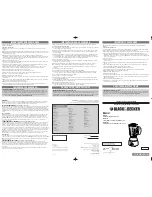
© MuxLab Inc.
2.
Verify that the distance between the HDMI Transmitter and Receiver is within
MuxLab specifications (see Specifications table).
3.
To install the Transmitter:
3a.
Connect the Transmitter to the HDMI video source with an HDMI compliant
cable.
3b.
Connect two (2) lengths of Cat 5e/6 (or higher) grade UTP cables to
HDMI LINK A and HDMI LINK B connectors on the Transmitter.
4.
To install the Receiver:
4a.
Connect the Receiver to the HDMI display equipment with an HDMI compliant
cable.
4b.
Connect the two (2) Cat 5e/6 cables to HDMI LINK A and HDMI LINK B
connectors on the Receiver.
Note: Verify that the cables are connected straight-through (
i.e.
, HDMI LINK A to
HDMI LINK A and HDMI LINK B to HDMI LINK B) and not inverted.
5.
Connect the 12 VDC power supply to the Receiver first, and then plug the power
supply into an AC power outlet. Connect the 12 VDC power supply to the
Transmitter first, and then plug the power supply into an AC power outlet. If power
is present, the green power LED of the Receiver will be ON. The power LED of
the Transmitter will only be ON when the source equipment (
i.e.
, DVD Player, PC,
etc.) is powered on.
Note: Power the HDMI IR/Extender Balun only after all connections are made.
6.
Power the HDMI equipment and verify the image quality.
7.
If infrared remote control is needed, connect the IR Sensor to the 3.5mm Stereo
Jack of the receiver and the IR Emitter to the 3.5mm Mono Jack of the Transmitter.
Note: You can differentiate the IR Sensor and the IR Emitter by looking at the
3.5 mm plug. The IR Sensor is using a Stereo Plug (3 Contacts) and the IR
Emitter a mono plug (2 Contacts).
8.
Position the IR Sensor so that it is directed to the hand-held remote control. For a
clear IR signal reception, aim the hand-held remote control to the top of the IR
Sensor enclosure.
9.
Position the IR Emitter as close as possible to the source’s IR Sensor (i.e. DVD
player). For a clear IR signal reception, the IR Emitter can be glued on the source’s
IR Sensor. The IR Emitter’s signal is transmitted from the side of the enclosure.
10.
The following diagram shows the final configuration.
Troubleshooting
The following table describes some of the symptoms, probable causes and possible
solutions in respect to the installation of the HDMI IR/Extender Kit:
Tx LED
Rx LED
Symptom
Power Sync Power Sync
Probable
Cause
Possible
Solutions
No Image
OFF
OFF
OFF
OFF No power
• Check power
connections
No Image
OFF
OFF
ON
OFF Source not
power on
• Power on source and
check the HDMI
cable of the source.
No Image
ON
OFF
ON
OFF Cable
• Check the UTP cables
pin-out.
• Verify that the UTP
cables are not crossed.
No Image
ON
ON
ON
OFF Synchronization • Check cable length.
• Check source
resolution versus
distance.
Flickering Image
ON
ON
ON
ON
Synchronization • Check cable length
Choppy sound
ON
ON
ON
ON
Synchronization • Check cable length
Green or pink hue
ON
ON
ON
ON
DDC
communication
• Cycle power of the
HDMI Extender.
• Check UTP cables
and replace.
Image flickers when
powering up nearby
equipment
ON
ON
ON
ON
Interference
• Use STP cables
IR not functioning
ON
ON
ON
ON
Remote control
not directed to
the IR Sensor or
IR Emitter not
directed to the
source.
• Make sure the IR
Sensor is directed
towards the remote
and the IR Emitter to
the equipment
IR not functioning
ON
ON
ON
ON
Interference
from sunlight,
Fluorescent,
Neon or
Halogen lights
• Place the IR
equipment away for
the interfering light
IR not functioning
ON
ON
ON
ON
Interference
from RF
radiation from
the TV
• Place the IR
equipment away for
the RF radiation
If you still cannot diagnose the problem, please call MuxLab Customer Technical
Support at 877-689-5228 (toll-free in North America) or (+1) 514-905-0588
(International).




















